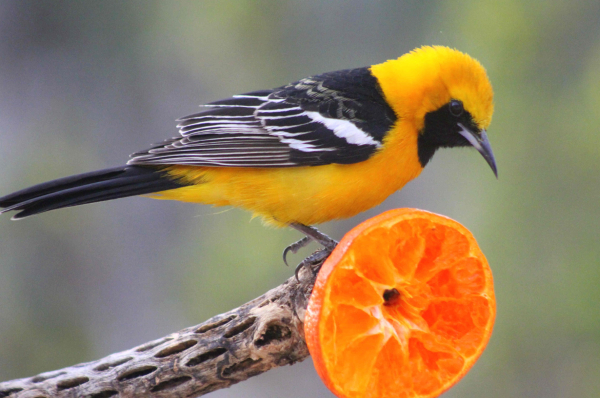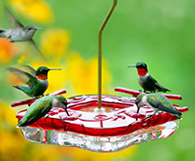
While sliced oranges will attract orioles and other birds like this Hooded Oriole, grape jelly has proven to be a better bird food to keep orioles in the area.

Many birders are finding they prefer nectar feeders like the Aspects Square Highview Hummingbird Feeder that provide clear views of all the feeder ports – and all the feeding hummingbirds.

As the nesting season winds down, orioles will begin moving beyond their spring territories, providing an opportunity to attract new birds to your feeding station. A simple oriole feeder like this Duncraft Oriole Feeder stocked with grape jelly and an orange slice will attract birds like this Baltimore Oriole, and keep them coming back for more.
|
How is your summer feeding station progressing? Summer has definitely become our favorite bird feeding period, providing more colorful birds, more bird songs, and more behaviors around the feeding station, while nesting activities abound around us. There was a time when most birders took down their feeders in April, when winter was over and most of the seed eaters returned northward. These days we know that simply by changing the menu a bit, we provide food for birds that migrate north from the tropics that remain from April or May thru September. Now we are seeing new fledglings at our feeding station, with more to come.
Growing in popularity each year among the birds we feed, grape jelly is now the staple food we provide and that many birds prefer from the end of April through September, including orioles, thrushes, tanagers, grosbeaks, and some finches. Sugar-water nectar is the other dominant offering, for hummingbirds of course, but some orioles relish sugar water too, along with occasional finches. Add fresh water to that combination, and you are set – or at least the birds are – most birds. Goldfinches still require thistle seeds, that might attract colorful buntings and other finches. And then there are the woodpeckers and nuthatches that usually prefer no-melt suet. Bigger seed eaters like cardinals and grosbeaks still prefer black oil sunflower seeds, and if you prefer to avoid the mess of discarded shells, offer shelled sunflower seeds – that’s our personal preference. You can always provide sliced oranges to attract orioles and other birds too, although we find that the oranges tend to be good to lure orioles to a feeding station, but they tend to be ignored when there is grape jelly available – at least that’s the case in our yard. Add fresh water for drinking and bathing to the mix, and you’re a one-stop pit stop for bird food and water!
Really, the above paragraph sums up everything you need to know about summer bird feeding. Provide it and they will come . . . it’s that simple. But everyone has a little different situation, with different habitats surrounding their feeding station, including urban and suburban habitats, and others. These variations can create quite different bird communities at locations just 20 miles apart, much less across a state or the continent. The key is to provide the foods that will attract the birds you most want to share your yard and feeding station with.
The Other Side of Summer Feeding
Summer feeding can be different from year to year, even month to month, but it is almost always especially rewarding. Provide the foods and see what happens; see what birds you attract. Hopefully you will be delighted with the results. But what happens when grackles or blackbirds take over a feeder? Or starlings? Or House Sparrows? Some people appreciate these birds just as much as closely related orioles and finches; but some people find them to be a problem, and when a big flock of grackles takes over your feeders and dominates your yard, it can make your bird feeding experience less than satisfying. Usually, the attraction is one food, or the problem may be the type of feeder it’s being offered in.
When shelled sunflower seeds are offered in an open dish or platform feeder, it’s easy access for Red-winged Blackbirds to take over. To address this concern, it’s just a matter of removing the foods in question, or providing the food in a feeder that doesn’t provide access for blackbirds, grackles, or starlings. First, these birds usually can’t break open sunflower seeds with their slim beaks, so by providing sunflower seeds in the shell, you can dissuade the unwanted birds to leave. You can also consider using a feeder that is surrounded by a cage to keep larger birds from accessing seeds, while permitting chickadees, finches, and other birds to feed within the caged feeder.
If another food attracts unwanted birds, suet for example, consider removing it for a time. Sometimes you can reintroduce the suet or another food after a few days, after the problem birds have relocated; sometimes it may take longer. But it’s all a part of the little challenges that come up periodically as the season progresses. Then too, every once in a while it’s worthwhile questioning your concerns about some birds – jays for example. Some people appreciate jays, some don’t; some people think they add character and color to a feeding station, others think they bully other birds they prefer at their feeders. Sometimes, it’s just a matter of appreciating how all birds fit together in nature, as well as at your feeding station.
Another summertime problem can be the attraction of bugs. For example, jelly can attract ants and occasional flies, but an ant moat can be helpful to limit access for ants. If you watch closely though, the first thing that orioles look for when they visit a jelly feeder is the bugs they can prey on before grabbing some jelly. Bees or wasps can also be attracted to jelly or sugar-water nectar, and some feeders offer relief by providing bee- and hornet-proof feeding ports. As with any small problem, we find a solution, which again may be to remove the problem food for a period so the bugs relocate.
However, when you do remove a food, it may keep some birds from their regular visits; but especially during the summer, there are plenty of food options, and maybe even other feeding stations nearby for them to use during a brief hiatus while things get sorted out at your feeding station.
Looking ahead, it’s never too early to start planning for the period of summer when hummingbirds, orioles, warblers, and other birds begin to flock, some creating family groups, others bonding together as they search for new food sources in preparation for their return to the tropics. Other local birds will behave similarly, including bluebirds, goldfinches, chickadees, and native sparrows, and they can produce some rewarding weeks at your feeding station when you have all the right foods and feeders available. Like anything else, a feeding station can be a fluid, changing activity, even challenging at times; but you are in control, and by varying the foods you offer, and how you offer them, you can enjoy the birds of summer in all the best possible ways.
Share your backyard birding experiences and photos at editorstbw2@gmail.com